|
Options
are financial
instruments that convey the right, but not the obligation,
to engage in a future transaction on some underlying security,
or in a futures contract. For example, buying a call option
provides the right to buy a specified quantity of a security
at a set strike price at some time on or before expiration,
while buying a put option provides the right to sell. Upon
the option holder's choice to exercise the option, the party
who sold, or wrote, the option must fulfill the terms of
the contract.[1]
The
theoretical value of an option can be determined by a variety
of techniques. These models, which are developed by quantitative
analysts, can also predict how the value of the option will
change in the face of changing conditions. Hence, the risks
associated with trading and owning options can be understood
and managed with some degree of precision.
|
|
|
Exchange-traded
options form an important class of options which have standardized
contract features and trade on public exchanges, facilitating
trading among independent parties. Over-the-counter options are
traded between private parties, often well-capitalized institutions,
that have negotiated separate trading and clearing arrangements
with each other. Another important class of options, particularly
in the U.S., are employee stock options, which are awarded by
a company to their employees as a form of incentive compensation.
Other types
of options exist in many financial contracts, for example real
estate options are often used to assemble large parcels of land,
and prepayment options are usually included in mortgage loans.
However, many of the valuation and risk management principles
apply across all financial options.
Contract
specifications
Every financial
option is a contract between the two counterparties with the terms
of the option specified in a term sheet. Option contracts may
be quite complicated; however, at minimum, they usually contain
the following specifications:[2]
- whether
the option holder has the right to buy (a call option) or the
right to sell (a put option)
- the quantity
and class of the underlying asset(s) (e.g. 100 shares of XYZ
Co. B stock)
- the strike
price, also known as the exercise price, which is the price
at which the underlying transaction will occur upon exercise
- the expiration
date, or expiry, which is the last date the option can be exercised
- the settlement
terms, for instance whether the writer must deliver the actual
asset on exercise, or may simply tender the equivalent cash
amount
- the terms
by which the option is quoted in the market, usually a multiplier
such as 100, to convert the quoted price into actual premium
amount
Types
of options
The primary
types of financial options are:
- Exchange
traded options (also called "listed options") are a class
of exchange traded derivatives. Exchange traded options have
standardized contracts, and are settled through a clearing house
with fulfillment guaranteed by the credit of the exchange. Since
the contracts are standardized, accurate pricing models are
often available. Exchange traded options include:[3][4]
- stock options,
- commodity
options,
- bond options
and other interest rate options
- index (equity)
options, and
- options
on futures contracts
- Over-the-counter
options (OTC options, also called "dealer options") are
traded between two private parties, and are not listed on an
exchange. The terms of an OTC option are unrestricted and may
be individually tailored to meet any business need. In general,
at least one of the counterparties to an OTC option is a well-capitalized
institution. Option types commonly traded over the counter include:
- interest
rate options
- currency
cross rate options, and
- options
on swaps or swaptions.
- Employee
stock options are issued by a company to its employees as
compensation.
Option
styles
-
Naming conventions
are used to help identify properties common to many different
types of options. These include:
- European
option - an option that may only be exercised on expiration.
- American
option - an option that may be exercised on any trading day
on or before expiration.
- Bermudan
option - an option that may be exercised only on specified dates
on or before expiration.
- Barrier
option - any option with the general characteristic that the
underlying security's price must reach some trigger level before
the exercise can occur.
Valuation
models
The value
of an option can be estimated using a variety of quantitative
techniques based on the concept of risk netral pricing and using
stochastic calculus. The most basic model is the Black-Scholes
model. More sophisticated models are used to model the volatility
smile. These models are implemented using a variety of numerical
techniques.[5] In general, standard option valuation models
depend on the following factors:
- The current
market price of the underlying security,
- the strike
price of the option, particularly in relation to the current
market price of the underlier,
- the cost
of holding a position in the underlying security, including
interest and dividends,
- the time
to expiration together with any restrictions on when exercise
may occur, and
- an estimate
of the future volatility of the underlying security's price
over the life of the option.
More advanced
models can require additional factors, such as an estimate of
how volatility changes over time and for various underlying price
levels, or the dynamics of stochastic interest rates.
The following
are some of the principal valuation techniques used in practice
to evaluate option contracts.
Black
Scholes
-
The Black-Scholes
model was the first quantitative technique to comprehensively
and accurately estimate the price for a variety of simple option
contracts. By employing the technique of constructing a risk neutral
portfolio that replicates the returns of holding an option, Fischer
Black and Myron Scholes produced a closed-form solution for a
European option's theoretical price.[6]
At the same time, the model generates hedge parameters necessary
for effective risk management of option holdings. While the ideas
behind Black-Scholes were ground-breaking and eventually led to
a Nobel Prize in Economics for Myron Scholes and Robert Merton,
the application of the model in actual options trading is clumsy
because of the assumptions of continuous (or no) dividend payment,
constant volatility, and a constant interest rate. Nevertheless,
the Black-Scholes model is still widely used in academic work,
and for many financial applications where the model's error is
within margin of tolerance.[7]
Stochastic
volatility models
-
Since the
market crash of 1987, it has been observed that market implied
volatility for options of lower strike prices are typically higher
than for higher strike prices, suggesting that volatility is stochastic,
varying both for time and for the price level of the underlying
security. Stochastic volatility models have been developed including
one developed by S.L. Heston.[8]
One principal advantage of the Heston model is that it can be
solved in closed-form, while other stochastic volatility models
require complex numerical models.[8]
Counterparty
risk
A further,
often ignored, risk in derivatives such as options is counterparty
risk. In an option contract this risk is that the seller won't
sell or buy the underlying asset as agreed. The risk can be minimized
by using a financially strong intermediary able to make good on
the trade, but in a major panic or crash the number of defaults
can overwhelm even the strongest intermediaries.
Trading
The most common
way to trade options is via standardized options contracts that
are listed by various futures and options exchanges. [11]
By publishing continuous, live markets for option prices,
an exchange enables independent parties to engage in price discovery
and execute transactions. As an intermediary to both sides of
the transaction, the benefits the exchange provides to the transaction
include:
- fulfillment
of the contract is backed by the credit of the exchange, which
typically has the highest rating (AAA),
- counterparties
remain anonymous,
- enforcement
of market regulation to ensure fairness and transparency, and
- maintenance
of orderly markets, especially during fast trading conditions.
Over-the-counter
options contracts are not traded on exchanges, but instead between
two independent parties. Ordinarily, at least one of the counterparties
is a well-capitalized institution. By avoiding an exchange, users
of OTC options can narrowly tailor the terms of the option contract
to suit individual business requirements. In addition, OTC option
transactions generally do not need to be advertised to the market
and face little or no regulatory requirements. However, OTC counterparties
must establish credit lines with each other, and conform to each
others clearing and settlement procedures. With few exceptions,[12]
there are no secondary markets for employee stock options. These
must either be exercised by the original grantee or allowed to
expire worthless.
The
basic trades of traded stock options
These trades
are described from the point of view of a speculator. If they
are combined with other positions, they can also be used in hedging.
Long
Call
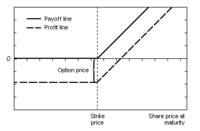
Payoffs
and profits from a long call.
A trader who
believes that a stock's price will increase might buy the
right to purchase the stock (a call option) rather than just
buy the stock. He would have no obligation to buy the stock, only
the right to do so until the expiration date. If the stock price
increases over the exercise price by more than the premium paid,
he will profit. If the stock price decreases, he will let the
call contract expire worthless, and only lose the amount of the
premium. A trader might buy the option instead of shares, because
for the same amount of money, he can obtain a larger number of
options than shares. If the stock rises, he will thus realize
a larger gain than if he had purchased shares
Short
Call
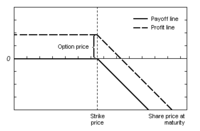
Payoffs
and profits from a naked short call.
A trader who
believes that a stock price will decrease, can sell the
stock short or instead sell, or "write," a call. Because both
strategies expose the investor to unlimited losses, they are generally
considered inappropriate for small investors. The trader selling
a call has an obligation to sell the stock to the call buyer at
the buyer's option. If the stock price decreases, the short call
position will make a profit in the amount of the premium. If the
stock price increases over the exercise price by more than the
amount of the premium, the short will lose money, with the potential
loss unlimited
Long
Put
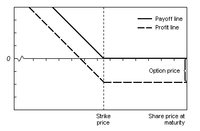
Payoffs
and profits from a long put.
A trader who
believes that a stock's price will decrease can buy the
right to sell the stock at a fixed price (a put option). He will be under
no obligation to sell the stock, but has the right to do so until
the expiration date. If the stock price decreases below the exercise
price by more than the premium paid, he will profit. If the stock
price increases, he will just let the put contract expire worthless
and only lose his premium paid.
Short
Put
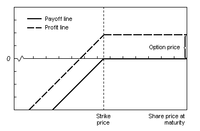
Payoffs
and profits from a naked short put.
A trader who
believes that a stock price will increase can buy the stock
or instead sell a put. The trader selling a put has an obligation
to buy the stock from the put buyer at the put buyer's option.
If the stock price increases, the short put position will make
a profit in the amount of the premium. If the stock price decreases
below the exercise price by more than the amount of the premium,
the trader will lose money, with the potential loss being up to
the full value of the stock.
Option
strategies
-
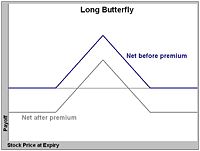
Payoffs
from buying a butterfly spread.
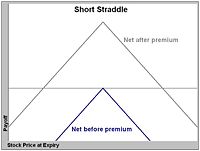
Payoffs
from selling a straddle.
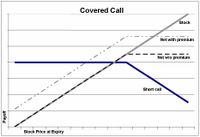
Payoffs
from a covered call.
Combining
any of the four basic kinds of option trades (possibly with different
exercise prices and maturities) and the two basic kinds of stock
trades (long and short) allows a variety of options strategies.
Simple strategies usually combine only a few trades, while more
complicated strategies can combine several.
Strategies
are often used to engineer a particular risk profile to movements
in the underlying security. For example, buying a butterfly spread
(long one X1 call, short two X2 calls, and long one X3 call) allows
a trader to profit if the stock price on the expiration date is
near the middle exercise price, X2, and does not expose the trader
to a large loss.
Selling a
straddle (selling both a put
and a call at the same exercise price) would give a trader a greater
profit than a butterfly if the final stock price is near the exercise
price, but might result in a large loss.
One well-known
strategy is the covered call, in which a
trader buys a stock (or holds a previously-purchased long stock
position), and sells a call. If the stock price rises above the
exercise price, the call will be exercised and the trader will
get a fixed profit. If the stock price falls, the trader will
lose money on his stock position, but this will be partially offset
by the premium received from selling the call. Overall, the payoffs
match the payoffs from selling a put.
Historical
uses of options
Contracts
similar to options are believed to have been used since ancient
times. In the real estate market, call options
have long been used to assemble large parcels of land from separate
owners, e.g. a developer pays for the right to buy several
adjacent plots, but is not obligated to buy these plots and might
not unless he can buy all the plots in the entire parcel. Film
or theatrical producers often buy the right but not the obligation
to dramatize a specific book or script. Lines of credit give the
potential borrower the right — but not the obligation — to
borrow within a specified time period.
Many choices,
or embedded options, have traditionally been included in bond
contracts. For example many bonds are convertible into common
stock at the buyer's option, or may be called (bought back) at
specified prices at the issuer's option. Mortgage borrowers have
long had the option to repay the loan early, which corresponds
to a callable bond option. In London, puts and "refusals" (calls)
first became well-known trading instruments in the 1690s during
the reign of William and Mary.[13]
Privileges
were options sold over the counter in nineteenth century America,
with both puts and calls on shares offered by specialized dealers.
Their exercise price was fixed at a rounded-off market price on
the day or week that the option was bought, and the expiry date
was generally three months after purchase. They were not traded
in secondary markets.
References
-
Brealey, Richard A.
& Myers, Stewart (2003),
Principles of Corporate Finance (7th ed.), McGraw-Hill,
Chapter 20
- "Characteristics and Risks of Standardized Options" (PDF).
Options Clearing Corporation. Retrieved on 2007-06-21.
- Trade CME Products. Chicago
Mercantile Exchange. Retrieved on 2007-06-21.
-
ISE Traded
Products. International Securites Exchange. Retrieved
on 2007-06-21.
- Reilly, Frank K. & Brown, Keith C. (2003), Investment
Analysis and Portfolio Management (7th ed.), Thomson Southwestern,
Chapter 23
- Black,
Fischer and Myron S. Scholes. "The Pricing of Options and
Corporate Liabilities," Journal of Political
Economy, 81 (3), 637-654 (1973).
- Hull, John C. (2005), Options, Futures and Other Derivatives
(6th ed.), Prentice-Hall, ISBN 0131499084
- Jim
Gatheral (2006). The Volatility Surface, A Practitioner's Guide. Wiley Finance.
ISBN 978-0471792512.
- Cox JC, Ross SA and
Rubinstein M. 1979.
Options pricing: a simplified approach, Journal of
Financial Economics, 7:229-263.[1]
- Cox, John C. & Rubinstein, Mark (1985),
Options Markets, Prentice-Hall, Chapter 5
- Harris, Larry (2003), Trading and Exchanges, Oxford
University Press, pp.26-27
-
Elinor Mills. "Google unveils unorthodox stock option auction", CNet, 2006-12-12.
Retrieved on 2007-06-19.
- Smith,
B. Mark (2003). History of the Global Stock Market from
Ancient Rome to Silicon Valley. University of Chicago
Press, p.20. ISBN 0-226-76404-4.
Further
reading
Business
press and web sites
- Callan Associates.
A Review of the CBOE S&P 500 BuyWrite Index (BXM). (October
2006).
- Clary,
Isabelle. "Wall Street Spreading the Word on Options -- Derivative Instruments
Now Being Pushed as Source of Better Returns, not Just for Hedging."
Pensions & Investments. (February 19, 2007).
- Hadi, Mohammed.
"Buy-Write Strategy Could Help in Sideways Market." Wall
Street Journal. (April 29, 2006) pg. B5.
- Tan, Kopin,
"Yield Boost -- Firms Market Covered-call Writing to Up Returns."
Barron's, (Oct. 25, 2004).
- Tergesen,
Anne. "Taking Cover with Covered Calls." Business Week, (May
21, 2001), pp. 132.
- Michael
C. "Getting Started in Options" Wiley, 2007; www.michaelthomsett.com
Academic
literature
- Fischer
Black and Myron S. Scholes. "The Pricing of Options and Corporate
Liabilities," Journal of Political
Economy, 81 (3), 637-654 (1973).
- Feldman,
Barry and Dhuv Roy. "Passive Options-Based Investment Strategies:
The Case of the CBOE S&P 500 BuyWrite Index." The Journal
of Investing, (Summer 2005).
- Kleinert,
Hagen, Path Integrals in Quantum Mechanics, Statistics, Polymer
Physics, and Financial Markets, 4th edition, World Scientific
(Singapore, 2004); Paperback ISBN 981-238-107-4 (also available
online: PDF-files)
- Hill, Joanne,
Venkatesh Balasubramanian, Krag (Buzz) Gregory, and Ingrid Tierens.
"Finding Alpha via Covered Index Writing." Financial Analysts Journal. (Sept.-Oct. 2006). pp. 29-46.
- Moran,
Matthew. “Risk-adjusted Performance for Derivatives-based
Indexes – Tools to Help Stabilize Returns.” The Journal of Indexes.
(Fourth Quarter, 2002) pp. 34 – 40.
- Reilly,
Frank and Keith C. Brown, Investment Analysis and Portfolio
Management, 7th edition, Thompson Southwestern, 2003, pp. 994-5.
- Schneeweis,
Thomas, and Richard Spurgin. "The Benefits of Index Option-Based
Strategies for Institutional Portfolios" The Journal of Alternative
Investments, (Spring 2001), pp. 44 - 52.
- Whaley,
Robert. "Risk and Return of the CBOE BuyWrite Monthly Index"
The Journal of Derivatives,
(Winter 2002), pp. 35 - 42.
|

